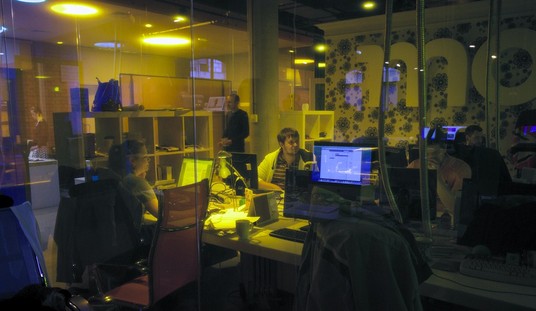A poll conducted on November 5 by Rasmussen Reports found that an all-time high of 68% of “likely U.S. voters” say that global warming is “a serious problem”; 38% of them thought it was “very serious.”
Considering the benefits of warming and the fact that even the UK Met office shows that there has been no global warming in the past 16 years, this demonstrates the degree to which the population has been propagandized into believing the opposite of reality. We are the first generation in history to believe that climatic warming is a bad thing.
In a warmer world, less energy is needed for heating and transportation, resulting in less air, land, and water pollution. Snow and ice that seriously hamper movement and increase the costs of land and water shipping are reduced. Roads, bridges, and other infrastructure maintenance costs drop, as there would be less freeze/thaw and ice damage. Clothing expenses obviously reduce in a warmer world, and construction costs plummet as less insulation is required in all buildings.
The benefits of warming are especially prominent in agriculture. Longer frost-free periods will extend growing seasons as well as the extent of agriculture in middle- and high-latitude regions. More and greater varieties of food are then possible in areas that are currently agriculturally marginal.
Contrary to the assertions of the United Nations Intergovernmental Panel on Climate Change (IPCC), a warmer world is a wetter world with less, not more, droughts. This is because evaporation increases with warming, putting more moisture into the atmosphere.
This week, we’ll be hearing in The Dirty Weather Report from Al Gore’s Climate Reality Project that global warming will lead to more extreme weather. This is wrong. In the exceptionally unlikely event that the world warms significantly due to increasing greenhouse gas emissions, temperatures at high latitudes are forecast to rise the most, reducing the difference between arctic and tropical temperatures. Since this differential drives weather, we should see weaker mid-latitude cyclones in a warmer world — less extremes in weather, not more. Rising global temperatures would produce a tranquilizing effect on weather, something we would all welcome.
Far more people die due to excessive cold than due to excessive warmth. Cold weather is obviously much harder on our bodies than is warm weather. That is why people retire to Florida or Arizona, and not Alaska.
History demonstrates that warming has been good, and cooling bad, for civilization. That is why geologists named past warm periods “optimums” and cold times “dark ages.”
It was during the warmest period since the end of the last ice age, a time called the Holocene Optimum between 9,000 and 5,000 years ago, that the first civilizations flourished in the Fertile Crescent of the Middle East. Other warm periods, climate optimums during Minoan, Roman, and Medieval times, and of course, the modern warm period, have all resulted in increased food productivity, lower death rates, and greater all-around prosperity.
In contrast, cold periods have been very rough on societies. The Dark Ages Cold Period between about 600 and 900 AD was a time of great retreat of agriculture and depression of human activity. There were plagues and starvation in many regions and people were forced to migrate away from farms in central Europe and Scandinavia.
The Little Ice Age (LIA) from about 1350 to 1850 was even worse; there was great misery for people around the world. Alpine glaciers overran mountain villages in Europe, and cold and wet weather killed millions of farm animals and ruined crops. With famine weakening the population, more than a third of Europeans died due to bubonic plague. People resorted to making bread from tree bark, and in some parts of Europe cannibalism was common. Later in the LIA, a million people died in Ireland and a million more left the country due to the Potato Famine brought on by the cold weather. Storms ravaged coastal settlements in both Europe and across the Pacific.
The IPCC 2007 Working Group II report on “Impacts, Adaptation and Vulnerability” states: “A focus on key vulnerabilities is meant to help policy-makers and stakeholders assess the level of risk and design pertinent response strategies.”
They are right. But it is impossible to do this without understanding the benefits of warming, and even more importantly, the dangers of cooling. The experience of India, which has prospered while warming over the past 50 years, demonstrates how well humans, even those living in hot climates, can adapt to warming. But cooling is a killer, and — scientists are increasingly telling us — a more probable event as well.
It has been found that the Earth is warmer when the Sun is more active as indicated by sunspot count. Our planet is cooler when there are fewer sunspots. The current 11-year sunspot cycle, Cycle 24, is already showing less spots than predicted, and expectations are for lower numbers still in Cycle 25, expected to start in about ten years. Not surprisingly, global temperatures have leveled and show signs of declining. By the mid- to late 2020s, conditions comparable to the LIA are a distinct possibility. Beginning to plan for adaptation to such a cool period should be a priority for governments. Besides, if you plan for cooling and it warms, adaptation is much easier than if you plan for warming and it cools.
President Barack Obama said in his victory speech last Wednesday: “We want our children to live in an America … that isn’t threatened by the destructive power of a warming planet.”
In the real world, we must forget about vainly trying to control global climate and instead get ready for the destructive power of a cooling planet.









Join the conversation as a VIP Member